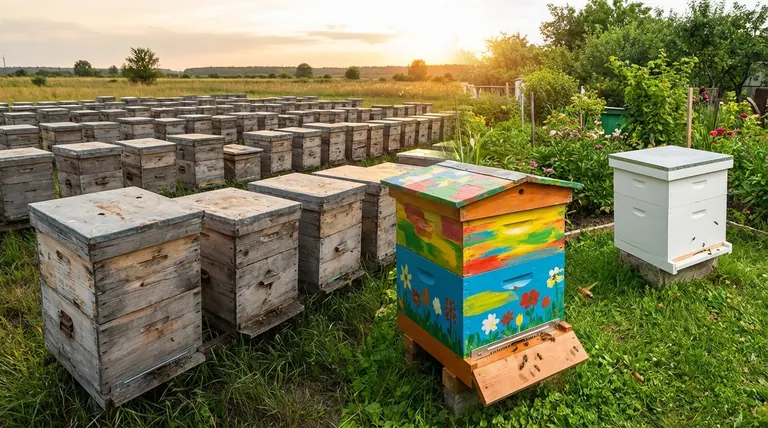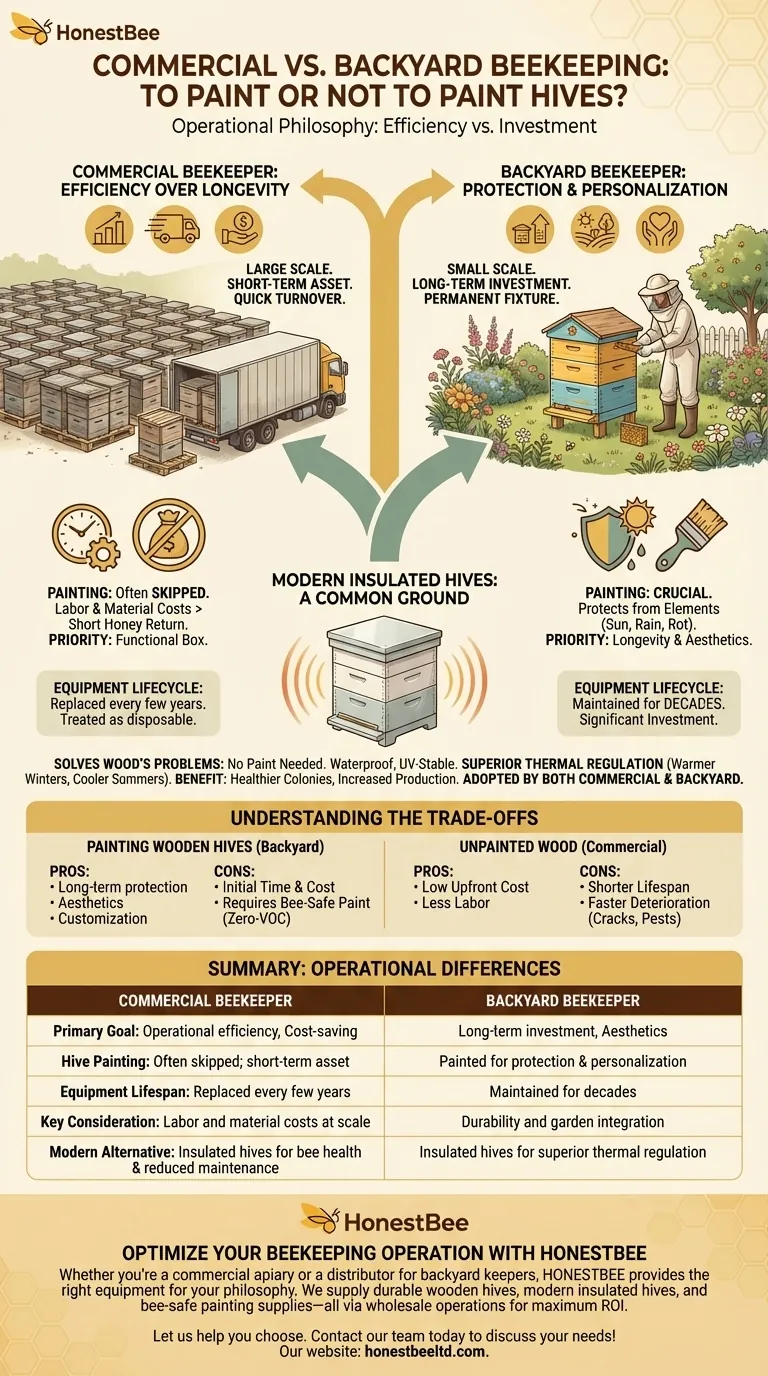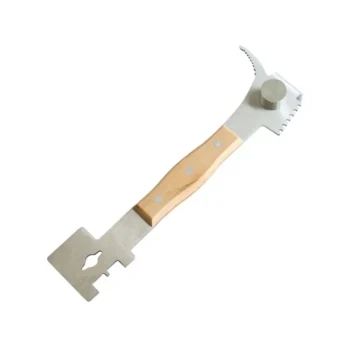In short, the difference comes down to operational philosophy. Commercial beekeepers often skip painting their hives because they treat them as short-term, disposable assets in a large-scale operation, replacing them every few years. Backyard beekeepers, however, view their hives as long-term investments and paint them for protection against the elements and for aesthetic appeal in their personal space.
The decision to paint a beehive is not merely about color; it is a direct reflection of the beekeeper's goals, scale, and time horizon. It pits the industrial logic of high-volume efficiency against the investment-focused mindset of the hobbyist.

The Commercial Beekeeper's Calculation: Efficiency Over Longevity
For a commercial beekeeper managing hundreds or thousands of colonies, every decision is magnified by scale. The approach to hive equipment is pragmatic and driven by return on investment.
Focus on Equipment Lifecycle
Commercial hives endure significant wear and tear from constant transport, heavy use, and exposure. Many operators find it more cost-effective to run the wooden boxes for a few seasons and then replace them entirely. Painting is an upfront cost with a payback period that may exceed the hive's planned service life.
The Impact of Scale and Cost
The labor and material costs to paint thousands of hive bodies are substantial. This expense provides little direct return in honey production, making it an easy cut for operations focused on maximizing profit margins. The priority is a functional box, not a pristine one.
The Backyard Beekeeper's Priority: Protection and Personalization
A backyard beekeeper typically manages a small number of hives and views them as a permanent fixture. This perspective fundamentally changes the cost-benefit analysis of hive maintenance.
Investing in Longevity
For the hobbyist, a beehive is a significant investment meant to last for many years, if not decades. A quality exterior paint job is the single most effective way to protect the wood from sun, rain, and rot, drastically extending the life of the equipment.
Aesthetics and Garden Integration
A beehive in a backyard is often a visual centerpiece. A well-maintained, painted hive is more attractive and integrates better into a garden setting. Many beekeepers also enjoy the creative aspect of personalizing their hives with unique colors and designs.
Beyond Paint: The Rise of Modern Hive Materials
The traditional debate over painting wooden hives is being reshaped by innovations in hive design. Insulated hives, often made from high-density polystyrene or other polymers, offer an alternative path to protection.
The Role of Insulation
These modern hives inherently solve the problems that paint addresses for wood. They are waterproof and UV-stable, requiring no external coating for protection. More importantly, they provide superior thermal regulation, keeping the colony warmer in winter and cooler in summer.
A Common Ground for All Beekeepers
This improved temperature control reduces the energy bees must expend on climate control, which can lead to healthier colonies and increased honey production. Because these benefits apply universally, both commercial and backyard beekeepers are adopting insulated hives to improve colony outcomes.
Understanding the Trade-offs
Neither approach is universally "correct." Each comes with clear advantages and disadvantages that align with different beekeeping goals.
The Cost of Painting
For the backyard beekeeper, painting requires an initial investment of time and money. It's crucial to use zero-VOC or low-VOC exterior latex paint to ensure it is bee-safe. The interior of the hive should never be painted.
The Limits of Unpainted Wood
While cost-effective in the short term, leaving wood unpainted guarantees a shorter lifespan. The equipment will deteriorate faster, potentially creating cracks and crevices that can harbor pests or diseases.
The Investment in Insulated Hives
Insulated hives offer superior performance but come with a higher upfront cost compared to traditional woodenware. This initial expense must be weighed against the long-term benefits of improved bee health and reduced maintenance.
Making the Right Choice for Your Goal
Your decision should be guided by your specific objectives as a beekeeper.
- If your primary focus is maximizing the life of your wooden hive: A thorough paint job with bee-safe exterior paint is your most effective strategy for long-term protection.
- If your primary focus is large-scale operational efficiency: Skipping paint is a valid cost-saving measure, provided you have a planned cycle for equipment replacement.
- If your primary focus is optimizing bee health and productivity: Consider investing in modern insulated hives to gain superior thermal performance and durability without the need for painting.
Ultimately, how you maintain your hive's exterior is a clear indicator of your underlying beekeeping philosophy and goals.
Summary Table:
| Aspect | Commercial Beekeeper | Backyard Beekeeper |
|---|---|---|
| Primary Goal | Operational efficiency, cost-saving | Long-term investment, aesthetics |
| Hive Painting | Often skipped; treated as short-term asset | Painted for protection and personalization |
| Equipment Lifespan | Replaced every few years | Maintained for decades |
| Key Consideration | Labor and material costs at scale | Durability and garden integration |
| Modern Alternative | Insulated hives for bee health and reduced maintenance | Insulated hives for superior thermal regulation |
Optimize Your Beekeeping Operation with HONESTBEE
Whether you're a commercial apiary focused on scalable efficiency or a distributor supplying backyard beekeepers, HONESTBEE provides the right equipment to match your philosophy. We supply durable wooden hives for long-term use, modern insulated hives for superior colony health, and bee-safe painting supplies—all through wholesale-focused operations designed to maximize your ROI.
Let us help you choose the best solution for your goals. Contact our team today to discuss your needs and explore our full range of beekeeping supplies and equipment!
Visual Guide

Related Products
- Wholesales Dadant Size Wooden Bee Hives for Beekeeping
- Professional Insulated Winter Hive Wrap for Beekeeping
- Professional Galvanized Hive Strap with Secure Locking Buckle for Beekeeping
- Long Langstroth Style Horizontal Top Bar Hive for Wholesale
- Professional Insulated Plastic Bee Hives
People Also Ask
- How often should the area under beehives be inspected and cleaned during the warm season? A Proactive Maintenance Guide
- Why were wooden hives traditionally preferred? For Natural Beekeeping Aligned with Bee Biology
- What should you do if you find an ant nest near your beehive? Essential Strategies for Hive Protection
- What are the essential pieces of equipment for most beekeepers? Get Started with the Right Gear
- What is the best place to keep bees? Find the Perfect Apiary Site for Your Hives



















